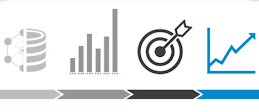Introduction:
Data Analytics(DA) is the process of examing data sets to draw conclusions, about the information they contain, increasingly with the aid of specialized systems and software.
Data Analytics technologies and techniques are widely used in commercial industries to enable organizations to make more-informed business decisions and by scientists and researchers to verify or disprove scientific models, theories, and hypotheses.
Depending on the particular application, the data that's analyzed can consist of either historical records or new information that has been processed for real-time analytics uses. Also, it can come from a mix of internal systems and external data sources.
Roles of Data Analytics
1. Determine Organizational goals:
One of the first and most important roles of data analytics to determine the organization's goal, that involves working with: IT teams, Management, Data Scientists.
2. Mining Data:
Data mining is a process to structure the raw data and formulate or recognize the various patterns in the data through mathematical and computational algorithms. It helps to generate new information and unlock the various insights. Data Analysis has too often mined or collects data. Getting data from the company database or extracting it from external sources to do any sort of research is one of the major roles of any Data Analyst.
3. Data Cleaning:
Data cleaning is the first step in the overall data analyzing, identifying, and correcting messy, raw data. The good analysis rests on clean data-it is as that cleaning involves removing data that may distort your analysis or standardizing your data into a signal format.
4. Analyzing data:
Needless to say, this role is a must for any data analysis. Data analysts are the art of exploring the facts from the data with specific to answer specific questions.
5. Creating reports with clear Visualizations:
Reporting translates raw data into information. reporting helps companies to monitor their online business and be alerted to when data falls outside of expected ranges. Good reporting should raise questions about the business from its end users.
6. Maintaining databases and Data systems:
Data Analysts have to ensure that the storage, availability, and coherence of electronically storing data meet an organization's needs. Data regarding data models, database design development to make the best use of it.
Features of Data Analytics:
- Data processing
- Predictive Applications
- Analytics
- Reporting Features
- Security Features
- Technologies Support
Opportunities for Data Scientist in industries:
In a world where 2.5 quintillion bytes of data are produced every day, a professional who can organize this humongous data to provide business solutions is indeed the hero!
A Data Scientist, according to Harvard Business Review, "is a high-ranking professional with the training and curiosity to make discoveries in the world of Big Data." Therefore, it comes as no surprise that data scientists are converted professionals in the Big data analytics and IT industry.
Real-World Applications Related to Data Scientists:
- Fraud and risk detection
- Healthcare
- Internal search
- Targeted advertising
- Website recommendations
- Advanced image recognition
- speech recognition
- Airline route planning
- Gaming
- Augmented reality
- Improves performance
- Quality and consistency
- Better decision making
- Excellent access to data
- Goods and services
- Profitable pricing
- Authentic data
- Splendid data
- Effective revenue
- Potential client value
Hope this article found you interesting. Thank You.
~Jinal Menpara



Nice work 👌
ReplyDeletevery interesting
ReplyDeletegood work..keep it up
ReplyDelete